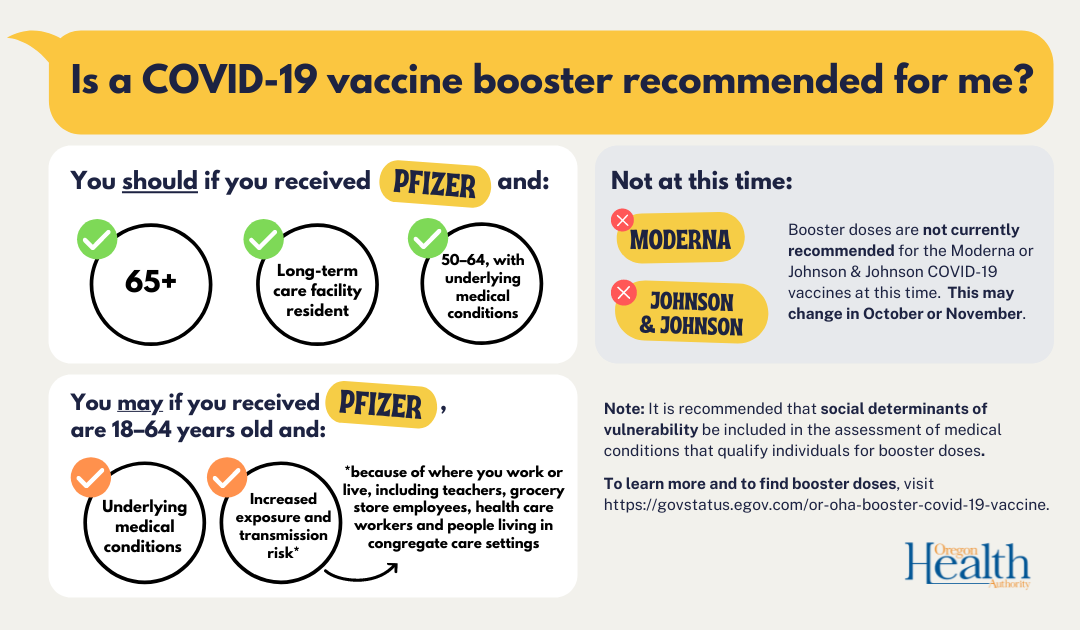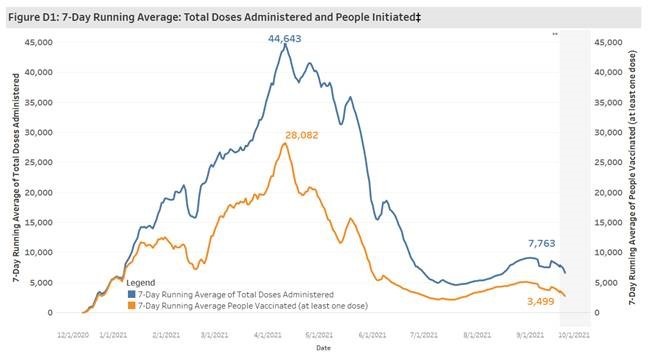Portland, Ore. — There are 21 new COVID-19 related deaths in Oregon, raising the state’s death toll to 3,682, the Oregon Health Authority reported Friday September 24, 2021.
Oregon Health Authority reported 2,113 new confirmed and presumptive cases of COVID-19, bringing the state total to 320,990.
Cases and COVID-19 related deaths
The new confirmed and presumptive COVID-19 cases reported today are in the following counties: Baker (15), Benton (38), Clackamas (153), Clatsop (10), Columbia (32), Coos (48), Crook (38), Curry (2), Deschutes (162), Douglas (53), Grant (11), Harney (24), Hood River (6), Jackson (90), Jefferson (42), Josephine (22), Klamath (58), Lake (24), Lane (171), Lincoln (18), Linn (148), Malheur (28), Marion (193), Morrow (8), Multnomah (275), Polk (33), Tillamook (17), Umatilla (93), Union (32), Wallowa (8), Wasco (24), Washington (161) and Yamhill (76).

Western States scientific safety review workgroup recommends Pfizer-BioNTech vaccine booster shot after six months for certain groups
The Western States Scientific Safety Review Workgroup today completed its review of the federal process and has recommended a booster dose of the Pfizer-BioNTech vaccine at least six months after their primary vaccination series for people older than 65 and people at higher risk for severe illness from COVID-19.
“Everyone eligible who wants a booster will get one, and I’m committed to ensuring our most vulnerable Oregonians are protected from COVID-19, including those who are at higher risk due to systemic health and social inequities. I’d like to thank Oregonians for their patience as boosters become available while our hospitals and health care workers continue to respond to the ongoing Delta surge,” said Governor Kate Brown.
The workgroup provided its confirmation to the governors of California, Nevada, Oregon, and Washington today. Click here to view the news release from Governor Kate Brown’s office.
Newest COVID-19 modeling report projects decrease in daily cases and hospitalizations
Today, the Oregon Health Authority released its latest COVID-19 forecast which shows a slowing in the decline in daily cases and hospitalizations through mid-October.
According to the report, the effective reproduction rate – the expected number of secondary cases that a single case generates – was estimated at .91 on Sept. 8, which is higher than last week’s projection. But the model still projects a decline in the estimated growth of new cases and hospitalizations over last week’s modeling scenario.
At that level of transmission, the report estimates 495 cases per 100,000 people, or an average of 1,480 daily cases and 81 hospitalizations for the two-week period between Sept. 29 and Oct. 12.
The modeling report also estimated the potential impact of a 20% increase in transmission.
Under that scenario, there would be an increase in newly diagnosed cases and hospitalizations, with an estimated average of 685 per 100,000 people, projecting an estimated average of 2,050 new cases and 118 hospitalizations over the same period.
The report also indicates that hospitals across the state are seeing declines in COVID-19 hospitalizations. However, COVID-19 bed occupancy levels remain higher than during previous surges.
The report also noted a slow increase in high-risk behaviors and protocol fatigue.
Vaccinations remain the most effective tool for slowing the spread of COVID-19. Oregonians should wear masks when in indoor public spaces and when outdoors among crowds.
To date more than 2.71 million Oregonians have received at least one dose of the safe and highly effective vaccine and 2.48 million people have completed a vaccine series.
Oregon launches self-administered case questionnaire
This week, Oregon launched a new self-administered COVID-19 case questionnaire. During times of surge, the number of cases outweighs public health’s capacity to complete a phone interview with all new cases. The new case questionnaire will shorten the phone call and enable cases to respond to most of the questions later. Local public health authorities will continue to call cases.
The local public health authorities that are offering the self-administered questionnaire will talk with the case, ask some demographic questions, refer them to essential support services for isolation if needed, determine if they are associated with any high-risk settings, and ask them to complete a self-administered case questionnaire.
Individuals will be given a link to the questionnaire to answer non-time sensitive questions. The survey is currently available in English and Spanish. Individuals who test positive should isolate in a safe place. If you need assistance call 211.
New graph shows running averages since beginning of vaccination effort
The overview tab of the Oregon COVID-19 Vaccine Daily Update dashboard includes tables which show the current 7-day running averages for total doses administered and people initiated. A new graph has been added to show these running averages over time since the beginning of the vaccination effort.
The running average for total doses administered accounts for all doses administered in Oregon, regardless of dose number (dose one versus dose two versus dose three, etc.). The running average for “people initiated” accounts for any person who received at least one shot of any COVID-19 vaccine.
The new graph will look like this example below:

COVID-19 hospitalizations
The number of hospitalized patients with COVID-19 across Oregon is 855, which is 30 fewer than yesterday. There are 268 COVID-19 patients in intensive care unit (ICU) beds, which is five more than yesterday.
|
9/24/2021 Available Beds (and Percentage of Staffed Beds Available) |
||||||||
|
|
Statewide |
Region 1 |
Region 2 |
Region 3 |
Region 5 |
Region 6 |
Region 7 |
Region 9 |
|
Adult ICU beds available |
60 (9%) |
24 (7%) |
9 (9%) |
10 (24%) |
7 (12%) |
2 (20%) |
2 (4%) |
6 (24%) |
|
Adult non-ICU beds available |
373 (9%) |
60 (3%) |
62 (9%) |
89 (14%) |
45 (10%) |
8 (16%) |
63 (16%) |
46 (40%) |
There are 60 available adult ICU beds out of 645 total (9% availability) and 373 available adult non-ICU beds out of 4,198 (9% availability).
The total number of patients in hospital beds may fluctuate between report times. The numbers do not reflect admissions per day, nor the length of hospital stay. Staffing limitations are not captured in this data and may further limit bed capacity.
Note: Please do not visit an emergency department for COVID-19 testing, unless you require emergency care for your symptoms.
Emergency departments in Oregon are under significant strain responding to the current surge in COVID-19. You can find a test here.
If you have a medical condition that doesn’t require emergency care, contact your provider. An urgent care center may also help you get the care you need and will save emergency departments from added strain.
More information about hospital capacity can be found here.
Vaccinations in Oregon
Today, OHA reported that 9,167 new doses of COVID-19 vaccinations were added to the state immunization registry on Sept. 23. Of this total, 3,810 were administered on Sept. 23: 1,538 were initial doses, 1,736 were second doses and 491 were third doses. The remaining 5,357 were administered on previous days but were entered into the vaccine registry on Sept. 23.
The seven-day running average is now 7,502 doses per day.
Oregon has now administered 2,943,192 doses of Pfizer Comirnaty, 1,896,037 doses of Moderna and 212,735 doses of Johnson & Johnson COVID-19 vaccines.
As of today, 2,721,546 people have had at least one dose of a COVID-19 vaccine and 2,488,494 people have completed a COVID-19 vaccine series.
These data are preliminary and subject to change.
Updated vaccination data are provided on Oregon’s COVID-19 data dashboards and have been updated today.
Learn more about COVID-19 vaccinations
To learn more about the COVID-19 vaccine situation in Oregon, visit our webpage (English or Spanish), which has a breakdown of distribution and other information

